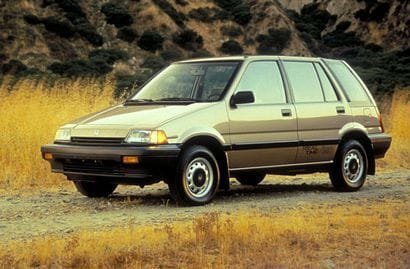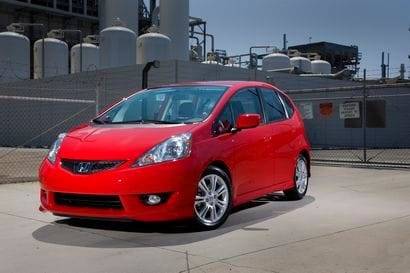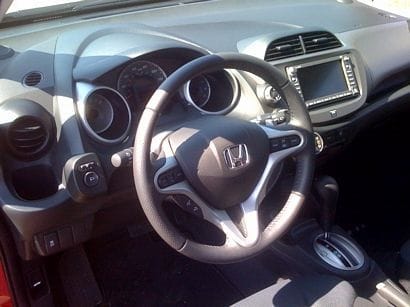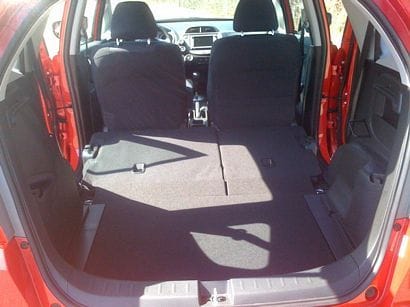A week in Honda's smallest passenger vehicle here in the US
Pros:
Excellent fuel economy
Versatile and configurable interior
Smooth switchgear
Solid and extremely tossable chassis
Cons:
Seat cushions too short
Lower door trim somewhat plasticky
Expensive navigation option

Family history
The first Honda I ever owned was a new 1987 Civic Wagon. It was 161.6 inches long, 64 inches wide, 59 inches tall and had a wheelbase of 96.5 inches. This Civic was white with white alloy wheels (an option I chose) and it was powered by a 1.5-liter SOHC 12 valve 4-cylinder engine that produced all of 76 horsepower. It also tipped the scales at 2,510 pounds and came equipped with a 5 speed manual transmission.
With a baby, not a lot of money and weekends spent bicycle riding, our family needed a comparatively spacious, economical, efficient small car and the Civic Wagon fit the bill perfectly.

Since 1987, Civics have continued to be the gold standard for compact cars, although they’ve grown and put on weight, much like I have, during the ensuing 24 years.
Current 2011 Civic models are, on average, 15 inches longer, 5 inches wider, 2.5 inches lower (in sedan form, there is no longer a wagon model), have a wheelbase 10 inches longer and are nearly 250 pounds heavier.
So while the new Civic is certainly at or near the top of the current class of compact cars, it has, along the way, forsworn its heritage as an über-efficient subcompact.

Fit for the new millennium
Enter the Fit. This five-door subcompact hatchback first appeared in Japan in 2001 as a 2002 model. Exported to Europe the following year, it wasn’t until April of 2003 that Honda saw fit (pun intended) to sell the model on our shores.
The second-generation Fit made its debut in the fall of 2007 as a 2008 model. Its width grew by an inch; wheelbase and overall length were up by 1.9 and 5.5 inches, respectively, while its height remained the same.
To put it in perspective, the 2011 Fit matches my 1987 Civic Wagon in length, but with a wheelbase that is nearly 2 inches longer. In other measurements, the newer Honda is 1 inch taller, 2.7 inches wider and has a track that is 1 inch wider in the front, but just a half inch wider in the rear.
More importantly, even with all its modern safety equipment, the Fit weighs less than 100 pounds more than the Civic Wagon and has 41 more horsepower.

Exterior
Outside, Honda has managed to give the boxy, cab-forward Fit quite a dose of style, even though it falls short of the likes of Ford’s new Fiesta. Fortunately, our sport model was able to hide some of its obvious shortcomings with a more aggressive lower front air dam (with fog lights), lower side sill kit and large upper rear spoiler.
The Sport model also adds one-inch larger tires (P185/55 R 16’s) wrapped around 16” X 6.0” alloy wheels

Interior
It’s inside where the Fit truly shines. A comparatively cavernous interior and low beltline combine to give it an airy feeling and contribute to excellent outward visibility.
The innovative rear “magic seats” allow users to configure the rear storage area in more than a dozen different ways. Trust me when I tell you that you can easily fit a 40 inch flat screen TV behind the front seats without having to take it out of the box.

All controls are within easy reach of the driver, while fit and finish as well as switchgear operation is flawless.
I only have a few nits to pick – the seat cushions could be a bit longer, the plastic on the lower door panels could use some sculpting to look less cheap and, at a premium of $1,530, you might want to forget about the Fit’s satellite-linked navigation system.

Equipment
In addition to the aforementioned Sport package, which also includes a leather-wrapped steering wheel and paddle shifters for the manumatic transmission, all Fits are equipped with air conditioning, electric power steering, power windows and locks as well as a tilt and telescoping steering wheel.
Other standard amenities include cruise, intermittent wipers and rear wiper/washer and defroster. Safety equipment includes a full compliment of 6 airbags, ABS, electronic brake distribution and brake assist as well as vehicle stability control.

On the road
On the road, the Fit is a whole lot of fun to drive. Its steering is precise and it feels well-planted. While it's hardly a sports car, tossing it through the twisties is a hoot.

The Bottom Line
It’s easy to see why the Fit topped Consumer Reports magazine’s best values list as well as Car and Driver’s "10 Best List". Its materials, fit and finish as well as utility are the benchmark of this class.
Add to this that elusive fun-to-drive factor and I come up with what is, in my opinion, a worthy and much improved successor to my 1987 Civic Wagon that is, without a doubt, the best subcompact car in America today.












